Podcast
Questions and Answers
What is the product of the reaction between a carboxylic acid and an alcohol?
What is the product of the reaction between a carboxylic acid and an alcohol?
- An acid and an alcohol
- Water and an acid
- A ketone and an acid
- An ester and water (correct)
What is the catalyst for the esterification reaction?
What is the catalyst for the esterification reaction?
- A base
- A weak organic acid
- An enzyme
- A strong mineral acid (correct)
What is the characteristic smell of esters?
What is the characteristic smell of esters?
- Bitter and acidic
- Sweet and fruity (correct)
- Pungent and sour
- Salty and metallic
What is the advantage of esters compared to carboxylic acids and alcohols?
What is the advantage of esters compared to carboxylic acids and alcohols?
What is the reaction between acetic acid and ethanol?
What is the reaction between acetic acid and ethanol?
What is the name of the reaction between a carboxylic acid and an alcohol, catalyzed by a strong mineral acid?
What is the name of the reaction between a carboxylic acid and an alcohol, catalyzed by a strong mineral acid?
What is the product of the intramolecular esterification reaction?
What is the product of the intramolecular esterification reaction?
What is the reason for the elimination of water in the esterification reaction?
What is the reason for the elimination of water in the esterification reaction?
What is the type of esterification reaction that occurs between 4-hydroxybutanoic acid and methanol?
What is the type of esterification reaction that occurs between 4-hydroxybutanoic acid and methanol?
What is the common use of esters?
What is the common use of esters?
Flashcards are hidden until you start studying
Study Notes
Esterification
- Esterification is a reaction between a carboxylic acid and an alcohol, catalyzed by a strong mineral acid (e.g., sulfuric acid or hydrochloric acid).
- The reaction produces an ester and water.
Mechanism of Esterification
- The carboxylic acid and alcohol react to form an ester and water.
- The reaction involves the elimination of water, with the hydrogen from the alcohol and the H from the carboxylic acid combining to form water.
Acetic Acid and Ethanol Reaction
- Acetic acid and ethanol react to form ethyl acetate and water.
- The reaction involves the elimination of water, with the hydrogen from ethanol and the H from acetic acid combining to form water.
Acetic Acid and Isobutanol Reaction
- Acetic acid and isobutanol react to form isobutyl acetate and water.
- The reaction involves the elimination of water, with the hydrogen from isobutanol and the H from acetic acid combining to form water.
Intramolecular Esterification
- Intramolecular esterification occurs when a carboxylic acid and an alcohol are part of the same molecule.
- The reaction forms a cyclic ester (lactone) and water.
4-Hydroxybutanoic Acid and Methanol Reaction
- 4-Hydroxybutanoic acid and methanol react to form a cyclic ester (lactone) and water.
- The reaction involves the elimination of water, with the hydrogen from methanol and the H from 4-hydroxybutanoic acid combining to form water.
Fischer Esterification
- Fischer esterification is a type of esterification reaction that occurs between a carboxylic acid and an alcohol, catalyzed by a strong mineral acid.
- The reaction produces an ester and water.
Characteristics of Esters
- Esters have a sweet, fruity smell.
- Esters are commonly used in perfumes, flavorings, and fragrances.
- Esters have a lower boiling point than carboxylic acids and alcohols.
Esterification Reaction
- Esterification occurs between a carboxylic acid and an alcohol, catalyzed by a strong mineral acid (e.g., sulfuric acid or hydrochloric acid).
- The reaction produces an ester and water.
Mechanism of Esterification
- The reaction involves the elimination of water, with the hydrogen from the alcohol and the H from the carboxylic acid combining to form water.
Examples of Esterification Reactions
- Acetic acid and ethanol react to form ethyl acetate and water.
- Acetic acid and isobutanol react to form isobutyl acetate and water.
- 4-Hydroxybutanoic acid and methanol react to form a cyclic ester (lactone) and water.
Intramolecular Esterification
- Intramolecular esterification occurs when a carboxylic acid and an alcohol are part of the same molecule.
- The reaction forms a cyclic ester (lactone) and water.
Fischer Esterification
- Fischer esterification is a type of esterification reaction that occurs between a carboxylic acid and an alcohol, catalyzed by a strong mineral acid.
- The reaction produces an ester and water.
Characteristics of Esters
- Esters have a sweet, fruity smell.
- Esters are commonly used in perfumes, flavorings, and fragrances.
- Esters have a lower boiling point than carboxylic acids and alcohols.
Studying That Suits You
Use AI to generate personalized quizzes and flashcards to suit your learning preferences.




